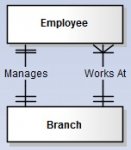See attached photo (sorry for bad quality).
This is how I have my database set up currently, except the part highlighted in red.
I was asked to see if I can use the CAT (one) to narrow down the CLIN (to many) and this is how I think it should be structured. Is it okay to have this kind of circular relationship within the database?
This is how I have my database set up currently, except the part highlighted in red.
I was asked to see if I can use the CAT (one) to narrow down the CLIN (to many) and this is how I think it should be structured. Is it okay to have this kind of circular relationship within the database?



